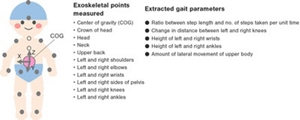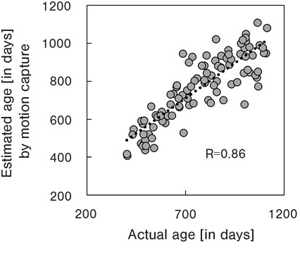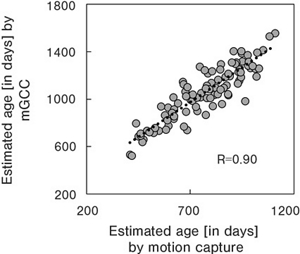Kao Develops a Technology for Analyzing a Person's Walking Movement Simply by Taking a Video with a Smartphone, etc.
― Kao plans to first use the technology to analyze toddlers' walking motions, with possible future application to assist elderly people to walk ―
Kao Corporation's Personal Health Care Products Research Laboratory and Sanitary Products Research Laboratories have jointly developed a new technology called "mobile Gait Change Capture (mGCC; pronounced 'em-jik')" which can analyze in detail a person's walking movement in 3D simply by taking a video in 2D, using the latest machine learning technology. Kao plans to initially apply this technology to study the growth and development of young children and later expand the research scope to include walking assistance for seniors among other applications, with the objective of improving people's quality of life (QOL) and promoting good health overall.
Kao's researchers presented their research findings at the 21st academic conference of the Japanese Society of Baby Science (held online on June 11 through 13, 2021).
2D video of a toddler walking captured with a smartphone, etc. is converted into 3D walking motion data.
mGCC Technology can analyze in detail a person's walking movement in 3D simply by taking a video in 2D
Kao Corporation has been conducting numerous studies on toddlers to analyze their walking movement, as part of its effort to develop better disposable baby diapers. In addition, as it intends to leverage its accumulated know-how on gait analysis to assist seniors with their walking, Kao has developed a system for analyzing adults' walking movement and has been researching the walking motions of wider demographics ranging from toddlers to seniors based on the gait data of over 30,000 volunteers. In recent years, the company has been developing new technology that enables deeper analysis of people's walking movement, utilizing a comprehensive foot pressure evaluation system that analyzes data sent from pressure sensor sheets, and a gait measuring instrument that uses motion capture technology.
Motion capture – a technology that is frequently used in motion analysis research – has the advantage of being able to analyze 3D gait movement with high accuracy. However, as it requires the installation of multiple infrared cameras in advance, this method has constraints as to where and when it can be used. Furthermore, as several reflective measurement markers must be put on the body whose motion is to be captured, it demands special skill and extra time.
To address these shortcomings, Kao's researchers explored an alternative approach that would allow analysis of a person's gait movement with greater ease, anywhere, and at any time, and has developed the mGCC technology that can perform in-depth analysis of a person's walking movement in 3D, simply by taking a video in 2D using a smartphone, etc. This technology uses machine learning to study 2D video footage of a person in motion, which is captured using an ordinary digital camera (RGB camera*1 ), compute the exoskeletal motions of the markers placed on the person's body as 3D data, and analyze it.
-
* 1 A type of camera that uses image sensor elements to convert visible red, green, and blue light into electrical signals and form photographic images as data of the three wavelengths.
Application to toddlers' gait analysis: Observation of their gait development made easy
To find a way of assisting young children that is optimized for their individuality and providing relevant information, Kao's researchers have developed this new method that allows parents to observe their children's gait development simply by using a smartphone, etc. to take videos of them walking.
This project was supervised and assisted by Dr. Hiroyuki Iwasaki of the Jujo Child Clinic, Dr. Hisashi Naito, Professor at Juntendo University's Graduate School of Health and Sports Science, and Dr. Da Jiang Lu, Professor at Shanghai University of Sport.
The study, conducted on 99 toddlers aged between 13 and 37 months (i.e., between 400 and 1,100 days), involved simultaneous filming of them walking, with both a conventional motion capture system and an ordinary digital camera. Then, from the 3D data acquired by motion capture, several gait parameters that exhibited high correlation to the toddlers' ages in days were selected (Figure 1) for multiple regression analysis to extrapolate each toddler's age in days from the data. Meanwhile, the 2D video footage captured with the digital camera was fed to mGCC for analysis, and the resulting 3D data was used to extrapolate each toddler's age in days based on the same gait parameters. The study examined how age-related development could be quantitatively inferred from the gait data acquired from the simple 2D video recording of the toddlers, by comparing the two data sets of age estimation.

Figure 1: Gait parameters highly correlated to age in days
The age estimation derived from the motion capture data exhibited high correlation to the toddlers' actual ages (Figure 2). The age estimation derived from the data captured using mGCC was then compared to the highly precise age estimation that used motion capture, which indicated that the two data sets were highly correlated (Figure 3). This proved that mGCC is nearly as precise as motion capture in estimating the toddlers' ages in days.

Figure 2: Age estimation by motion capture

Figure 3: Comparison of age estimation
between motion capture and mGCC
Summary and future plans
This mGCC technology developed by Kao's researchers enables monitoring of toddlers' gait development simply by taking their videos in daily life activities using a smartphone, etc. without the trouble of having to set up an elaborate measuring system each time. Kao Corporation plans to expand the application of mGCC beyond young children to include adults and elderly people for analysis of their walking movement, as part of its larger mission of researching and developing technology that will improve people's QOL and promote good health all around, from the perspective of people's gait behavior through different stages of their lives.
About Kao
Kao creates high-value-added products that enrich the lives of consumers around the world. Through its portfolio of over 20 leading brands such as Attack, Bioré, Goldwell, Jergens, John Frieda, Kanebo, Laurier, Merries, and Molton Brown, Kao is part of the everyday lives of people in Asia, Oceania, North America, and Europe. Combined with its chemical division, which contributes to a wide range of industries, Kao generates about 1,400 billion yen in annual sales. Kao employs about 33,000 people worldwide and has 130 years of history in innovation. Please visit the Kao Group website for updated information.
Media inquiries should be directed to:
Corporate Strategy
Kao Corporation
